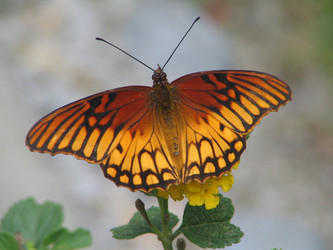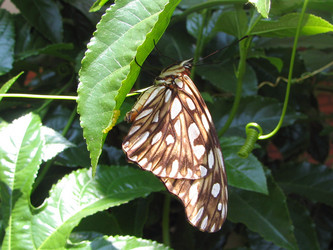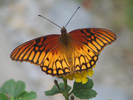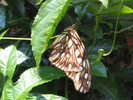Dione
Andrew V. Z. Brower and Margarita Beltrán


This tree diagram shows the relationships between several groups of organisms.
The root of the current tree connects the organisms featured in this tree to their containing group and the rest of the Tree of Life. The basal branching point in the tree represents the ancestor of the other groups in the tree. This ancestor diversified over time into several descendent subgroups, which are represented as internal nodes and terminal taxa to the right.

You can click on the root to travel down the Tree of Life all the way to the root of all Life, and you can click on the names of descendent subgroups to travel up the Tree of Life all the way to individual species.
For more information on ToL tree formatting, please see Interpreting the Tree or Classification. To learn more about phylogenetic trees, please visit our Phylogenetic Biology pages.
close boxIntroduction
A widespread neotropical genus. The butterflies in this genus are recognized by the orange upperside, reflective silver spots on the underside, and the shape of the antennal club (DeVries, 1997).
The hostplants are all members of the Passifloraceae. Dione is able to utilize a great number of species and subgroups of Passiflora. The eggs are laid in large groups on old leaves, and the larvae can be agricultural pests in passion flower farms. The larvae are almost unicolored, spiny and gregarious feeders. The pupae are not spined, and in general are dull and cryptic (DeVries, 1997) (see each species for more details).
Etymology: DIONE was the goddess of the oracle of Dodona in Thesprotia, and the mother of Aphrodite by Zeus. Her name is simply the feminine form of Zeus (Dios) (DIONE).
References
DeVries P. J. 1997 The Butterflies of Costa Rica and Their Natural History, Volume I: Papilionidae, Pieridae, Nymphalidae Princeton University Press, Baskerville, USA.
Dione. Theoi Greek Mythology. http://www.theoi.com/Titan/TitanisDione.html [Accessed 26 August 2008]
Lamas G ed. 2004. Atlas of Neotropical Lepidoptera. Checklist: Part 4A Hesperioidea - Papiionoidea. Gainesville: Scientific Publishers/Association of Tropical Lepidoptera.
Title Illustrations

| Scientific Name | Dione moneta |
|---|---|
| Location | Mexico City, Mexico |
| Specimen Condition | Live Specimen |
| Life Cycle Stage | Adult |
| Source | http://www.maryposa.org |
| Source Collection | Maryposa |
| Copyright |
© Maria Franco

|
| Scientific Name | Dione juno |
|---|---|
| Location | Mexico City, Mexico |
| Comments | Dione juno lays eggs in clusters. |
| Specimen Condition | Live Specimen |
| Sex | Female |
| Life Cycle Stage | Adult |
| Source Collection | Maryposa |
| Copyright |
© Maria Franco

|
About This Page

Middle Tennessee State University, Murfreesboro, Tennessee, USA

University of Cambridge, Cambridge, UK
Correspondence regarding this page should be directed to Andrew V. Z. Brower at and Margarita Beltrán at
Page copyright © 2013 and
 Page: Tree of Life
Dione .
Authored by
Andrew V. Z. Brower and Margarita Beltrán.
The TEXT of this page is licensed under the
Creative Commons Attribution License - Version 3.0. Note that images and other media
featured on this page are each governed by their own license, and they may or may not be available
for reuse. Click on an image or a media link to access the media data window, which provides the
relevant licensing information. For the general terms and conditions of ToL material reuse and
redistribution, please see the Tree of Life Copyright
Policies.
Page: Tree of Life
Dione .
Authored by
Andrew V. Z. Brower and Margarita Beltrán.
The TEXT of this page is licensed under the
Creative Commons Attribution License - Version 3.0. Note that images and other media
featured on this page are each governed by their own license, and they may or may not be available
for reuse. Click on an image or a media link to access the media data window, which provides the
relevant licensing information. For the general terms and conditions of ToL material reuse and
redistribution, please see the Tree of Life Copyright
Policies.
- First online 25 March 2007
- Content changed 04 September 2008
Citing this page:
Brower, Andrew V. Z. and Margarita Beltrán. 2008. Dione . Version 04 September 2008 (under construction). http://tolweb.org/Dione/72861/2008.09.04 in The Tree of Life Web Project, http://tolweb.org/









 Go to quick links
Go to quick search
Go to navigation for this section of the ToL site
Go to detailed links for the ToL site
Go to quick links
Go to quick search
Go to navigation for this section of the ToL site
Go to detailed links for the ToL site